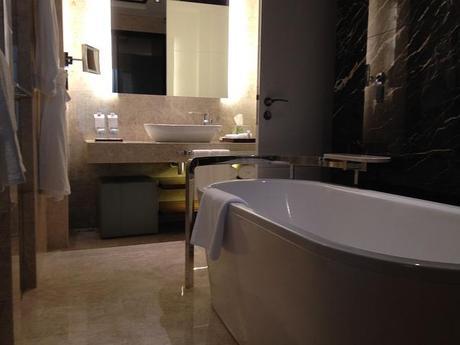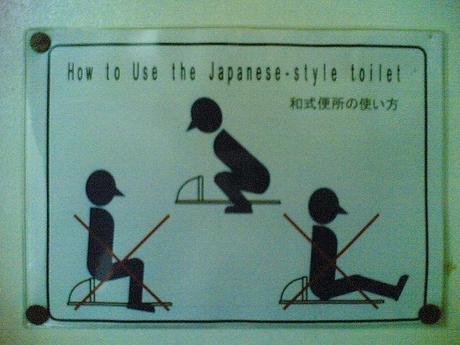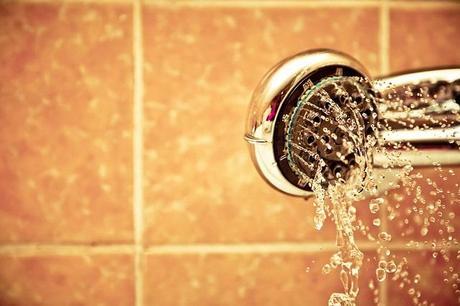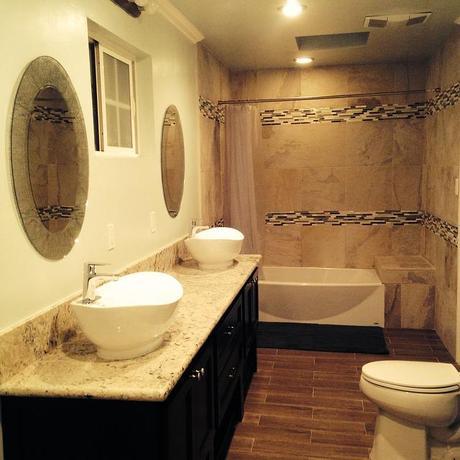I recently came across an article on The Guardian that poked at my curiosity. Lloyd Alter, Managing Editor at Tree Hugger, noted that the modern bathroom is “wasteful and unhealthy.” Although I agree that we still have miles to go, I’d like to highlight the ways in which modern bathroom design has promoted sanitation and responsible use.
The design of the modern bathroom was initiated in order to promote hygiene and reduce plumbing costs. I propose that while the modern bathroom does allow you to use excessively, there are many ways to reduce water consumption in the bathroom. The choice is up to you.

Water Efficiency and Hygiene in the Bathroom
The bathroom; how peculiar is it that this is the place in which we both wash up, and handle our dirty business. It almost seems counter intuitive to have a these two fixtures within a shared vicinity, especially so with open-space bathrooms. Yet and still, this architectural layout was planned for a reason. By placing the toilet, shower, and wash basin in the same room, you would decrease the cost of running plumbing to different areas of the home. Steven Corley Randel did a great piece on Houzz about bathroom measurements that explains this well.
Yes, having a water tap does ALLOW you to run water down the drain 24 hours a day if you so please, but water usage is charged often billed on a tiered rating system. This is done to deter individuals from excessive water consumption.
[READ: 7 Smart Bathroom Ideas Any Homeowner Will Love]
–Points that I agree With–
Toxic Output of Incredible Waste
This is correct. The amount of waste products being introduced into the environment is frightening, not to mention storm water runoff. We need more eco-friendly solutions. Maybe waterless composting toilets could be the solution. It may take some getting used to but we might not have a choice in a few years.
The Bidet
The bidet is a meaningful solution that should be considered. I wrote about the adoption of the bidet in America earlier last month. Do bidets still hold a negative connotation associated with brothels that American soldiers witnessed while deployed during WWI? Bidets reduce water consumption AND electrical consumption. 6% of a cities electrical bill is used to pump water. This is a way that we can go both Off-the-Grid AND Off-the-Pipe in Lloyd’s words!
The Toilet is too High

The Japanese Toilet makes you squat down to use the loo. (Source)
There’s no fighting this one. The toilet is designed too high, especially comfort height toilets. This is one area where we could take from Japanese Bathrooms. Japanese toilets are essentially built on the ground, making you squat when you use the bathroom. There are many new toilets out there that seek to improve in this area. One in particular is a prototype called The Well-Being Toilet.

How to Use a Japanese Toilet. (Source)
Since the 1994 Energy Efficiency Act was mandated, toilets have gone from 5-7 GPF to 1.6 GPF with ultra low-flow toilets. According to EPA estimates, the toilet accounts for 27% of residential water usage. The loo is a good place to start if we’re combating inefficiency.
[READ: Thomas Crapper: The History of the Crapper]
–Reasons Why Modern Design is Efficient and Sanitary–
Sink Height
One thing that was mentioned was sink height. Standard vanities are 32″ however, there is such a thing as a “Comfort Height Vanity.” Comfort height bath vanities are the same height as kitchen countertops (36″) to reduce stooping and encourage a more natural posture.
Low-Flow Shower Heads
Lloyd referred to these water saving fixtures as “miserable low flow shower heads.” Does dumping a ladle (basically a cup of water) over your head offer more water than a low-flow shower head? I find that hard to believe. If you feel bad shortening your shower time, you may want to understand the reason in which you’re doing so. We’re running out of water.
“Water companies often give away timers that help you limit your time in the shower and attachments are available to fix to your shower head that will reduce the flow but not the bathing experience.”
-Dr. Paula Owen, Independent Environmental Consultant
The average shower takes 8 minutes. In a statement made to BBC News, Dr. Own advises people to take 4 minute showers.
Normal shower heads use 5 GPM and low-flow shower heads cut this in half to 2.5 GPM. Not bad right? That’s just the start. According to the Study on Water Conservation by Water Saving Fixture conducted by The Department of Architecture at Tokyo Metropolitan University, spray flow faucets reduce hot water consumption by 27.3%.

Lloyd also states that the Japanese method of bathing uses 10% of the water as a normal shower. A normal showerhead uses 16.38 gallons of water. 10% of this would be 1.638 or the equivalent of a single flush from an ultra-low flow toilet. Washing up with a gallon and a half of water is more convenient than a low-flow shower head? I think not.
Also, you don’t have to use a ladle to be a water conscious user. A normal bathtub holds 15.85 gallons of water. You can run your bathwater a couple of inches deep. This is how you can practice water conservation in a modern bathroom. It is possible for the modern bathroom to be efficient! We just have to be wise about our decisions.
The Toilet Sends Bacteria into the Air
Research has proven that flushed toilets do send bacteria into the air. That’s disturbing but, did you know that the keyboard you’re typing at has 80x more germs than a toilet! That’s why the proper way to flush a toilet is to close the lid first. Excrements can fly airborne as much as 2 meters in the air if the lid is open. The solution, close the lid before you flush!
Kohler Co. recently introduced a new Touchless Toilet that allows you to flush at the wave of a hand. This new technology comes built into fixtures and can also be installed into existing toilets with a $99 adapter.
[READ: Are Automatic Faucets are Covering Your Hands in Germs]
The Shower is a “Deathtrap”
Although I agree that the shower can be a very dangerous place, grab bars make it easier to maintain your balance in the bathroom. Furthermore, investing in a rubber shower mat can eliminates slips in the bathroom entirely. Here are some more bathroom safety tips from National Bath Safety Month.
Inadequately Ventilated Room
Bathrooms are supposed to be properly ventilated by use of a ventilation fan and/or window. Depending on the size of your bathroom, your extractor fan should hold be able to blow air through the roof at a specified rate, Cubic Feet per Minute or CFM. Ventilation problems can be caused by clogged ventilation pipes.
The Solution to All of This
By taking 4 minute showers (50% water savings), using a shower head stop button (27.3% WS), and installing a low-flow shower head (50% WS), you can reduce water consumption to 6.825% of a normal 8 minute long shower. 6.825% in comparison to the 10% of a traditional Japanese tub and ladle. Sounds like the modern bathroom can actually be more efficient for $20 of attachments. Not bad right?

Conclusion
What then is the solution? Return to the days when sewage was overflowing our gutters and risk another Cholera epidemic? There is no perfect solution but we have to consider what the BEST solution would be. It’s not enough to point out the inadequacies of modern society. We have to offer alternative solutions.
Yes, we can say that modern plumbing has facilitated excessive use, but this is a far cry from the modern bathroom being “wasteful and unhealthy.” The modern bathroom does ALLOW us to be wasteful, but there are many ways to prevent this if YOU take responsibility.
Yes, we no longer have to walk down to the water pump in order to retrieve water but is that a bad thing? It offers convenience. It’s up to us how we use it. Have we become so lazy that we can’t turn the knob down every now and then?
As for sanitation, it’s not exactly spotless but it’s miles ahead of the cesspools of the 18th century. Modern plumbing promotes proper sanitation and healthy hygiene. That’s one of the main motivations behind the “Reinvent the Toilet Fair” headed by the Bill & Melinda Gates Foundation.
The modern bathroom is being refined. Nothing will ever be perfect but manufacturers and homeowners are making strides in the right direction. Share your thoughts in the comments or send me a tweet @SuperInteriors. Thanks for starting a discussion on this area Lloyd!
References:
- The Guardian. Why the Modern Bathroom is a Wasteful, Unhealthy Design. Retrieved 7/15/2014.
- Bathroom Behaviour; How to Optimise Bathroom Space for Modern Households – The Ideal Standard Study
- BBC News. People’s Showering Habits Revealed in Survey. Retrieved 7/15/2014.
- Department of Architecture, Graduate School of Urban Environmental Sciences, Tokyo Metropolitan University, Japan. Study on Water Conservation by Water Saving Fixtures.
More Water Conservation Ideas:
- 4 Reasons Why Water Conservation Effects You!
About the Author
Cheryl Khan is an interior designer and freelance writer who loves reading about new green products. She believes that consumers need to become “Smart Users” who stop to think about how they go about their day-to-day lives.
